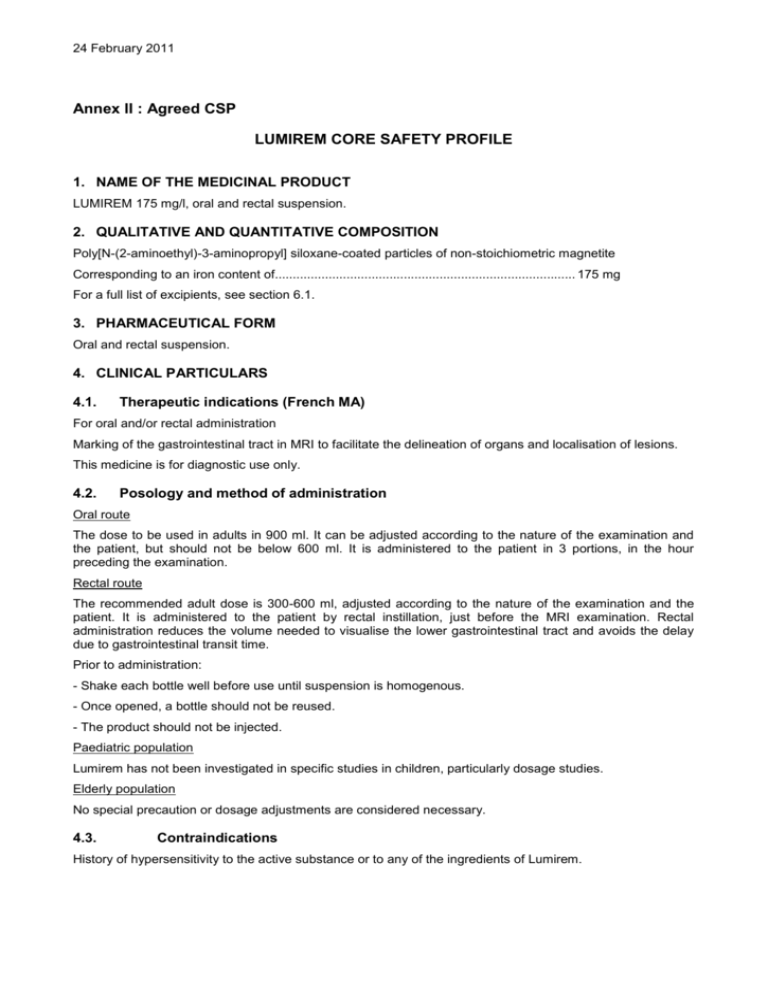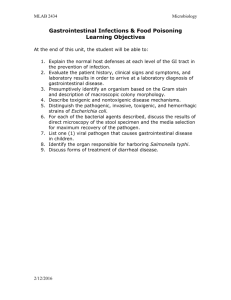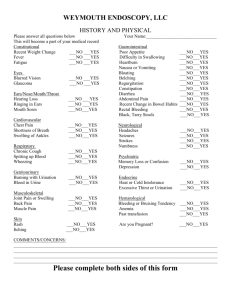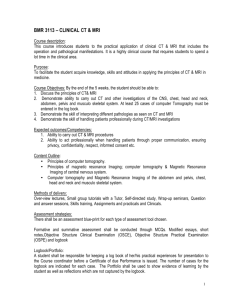24 February 2011 Annex II : Agreed CSP LUMIREM CORE SAFETY
advertisement

24 February 2011 Annex II : Agreed CSP LUMIREM CORE SAFETY PROFILE 1. NAME OF THE MEDICINAL PRODUCT LUMIREM 175 mg/l, oral and rectal suspension. 2. QUALITATIVE AND QUANTITATIVE COMPOSITION Poly[N-(2-aminoethyl)-3-aminopropyl] siloxane-coated particles of non-stoichiometric magnetite Corresponding to an iron content of.................................................................................... 175 mg For a full list of excipients, see section 6.1. 3. PHARMACEUTICAL FORM Oral and rectal suspension. 4. CLINICAL PARTICULARS 4.1. Therapeutic indications (French MA) For oral and/or rectal administration Marking of the gastrointestinal tract in MRI to facilitate the delineation of organs and localisation of lesions. This medicine is for diagnostic use only. 4.2. Posology and method of administration Oral route The dose to be used in adults in 900 ml. It can be adjusted according to the nature of the examination and the patient, but should not be below 600 ml. It is administered to the patient in 3 portions, in the hour preceding the examination. Rectal route The recommended adult dose is 300-600 ml, adjusted according to the nature of the examination and the patient. It is administered to the patient by rectal instillation, just before the MRI examination. Rectal administration reduces the volume needed to visualise the lower gastrointestinal tract and avoids the delay due to gastrointestinal transit time. Prior to administration: - Shake each bottle well before use until suspension is homogenous. - Once opened, a bottle should not be reused. - The product should not be injected. Paediatric population Lumirem has not been investigated in specific studies in children, particularly dosage studies. Elderly population No special precaution or dosage adjustments are considered necessary. 4.3. Contraindications History of hypersensitivity to the active substance or to any of the ingredients of Lumirem. 24 February 2011 Contraindications associated with MRI: Patients with pacemakers, ferromagnetic vascular clips, infusion pumps, nerve stimulators, cochlear implants, or suspected intracorporal metallic foreign bodies, particularly in the eye. 4.4. Special warnings and precautions for use There is a risk of hypersensitivity, regardless of the dose administred. 4.4.1 Warnings All MRI contrast agents can lead to minor or major hypersensitivity reactions, which can be life-threatening. These hypersensitivity reactions are of an allergic nature (known as anaphylactic reactions if they are serious) or a non-allergic nature. They can be immediate (occurring within 60 min) or delayed (not occurring until up to 7 days later). Anaphylactic reactions are immediate and can be fatal. They are dose-independent, can occur right from the first administration of the product, and are often unforeseeable. The risk of a major reaction means that the equipment needed for emergency resuscitation must be immediately to hand. Patients who have already experienced a reaction after a previous administration of a product containing iron particules are at increased risk of another reaction on readministration of the same or possibly another product and are thus regarded as at-risk patients. Although iron has not been shown to cross the gastrointestinal barrier in clinical studies in humans, any evaluations of iron metabolism should preferably be carried out not too near to the time of the examination. 4.4.2 Precautions for use 4.4.2.1. Hypersensitivity to MRI contrast agents Before the examination: Identify patients at risk through precise questioning about their history. Corticosteroids and H1 antihistamines have been proposed as premedication in patients at greatest risk of intolerance reactions (those known to be intolerant to a contrast agent). They do not prevent the occurrence of severe or fatal anaphylactic shock, however. Throughout the examination, it is necessary to ensure the following: Medical monitoring Maintenance of venous access After the examination: After administration of a contrast agent, the patient must be kept under observation for at least 30 min, as most of the serious undesirable effects occur within this period. The patient must be warned of the possibility of delayed reactions (occurring up to 7 days after administration) (cf. section 4.8 Undesirable effects). 4.4.2.2 Warning about excipients In the case of patients on a sodium-free or low-sodium diet, take account of the sodium content: 100 ml contains 100 mg sodium. This medicine contains an azo dye, sunset yellow colouring agent (E110), propyl hydroxybenzoate (E216) and methyl hydroxybenzoate (E218), which may cause allergic reactions (possibly delayed in the two latter cases). This medicine contains sorbitol. Its use is inadvisable in patients with fructose intolerance (a rare hereditary disorder). 24 February 2011 4.5. Interaction with other medicinal products and other forms of interaction Combinations that need to be taken into account Beta blockers, vasoactive substances, angiotensin-converting enzyme inhibitors, angiotensin-receptor blockers: these medicines reduce the effectiveness of the cardiovascular mechanisms that compensate for blood-pressure disturbances: the doctor should be informed about these prior to the administration of Lumirem and have resuscitation equipment at hand. 4.6. Pregnancy and lactation Pregnancy There are no data on the use of Lumirem in pregnant women. Animal studies have not shown any direct or indirect adverse effects on reproduction (see section 5.3). As a precaution, use of Lumirem should preferably be avoided during pregnancy. Lactation No effect on breastfed babies/neonates is expected, as the breastfeeding woman's systemic exposure to Lumirem is negligible. 4.7. Effects on ability to drive and use machines The effects on the ability to drive and to use machines have not been investigated. 4.8. Undesirable effects The undesirable effects linked to the use of Lumirem are usually mild to moderate in intensity and transient. Since Lumirem came onto the market, the undesirable effects most commonly encountered following its administration are gastrointestinal reactions and peribuccal or anal paraesthesia of a transient nature. Hypersensitivity reactions are possible, notably because of the presence of Sunset yellow. In these reactions the most commonly observed effects are cutaneous effects, which can be localised, extensive, or generalised. These reactions may involve one or more effects, occurring concomitantly or successively, and usually including cutaneous, respiratory and/or cardiovascular manifestations, each of which can be a warning sign of incipient shock and, in very rare instances, can even prove fatal. The undesirable effects are presented in the table below, by system organ class and by frequency using the following categories: very common ( 1/10), common (1/100 to 1<1/10), uncommon (1/1000 to 1<1/100), rare (1/10,000 to <1/1000), very rare (<1/10,000), not known (cannot be estimated from the available data). System organ class Frequency: undesirable effect Immune system disorders Unknown: hypersensitivity Nervous system disorders Unknown: paraesthesias Gastrointestinal disorders Unknown: diarrhoea, abdominal pain, nausea, abdominal distension, flatulence, dyspepsia Unknown: feeling cold General disorders conditions and administration site Undesirable effects in children The expected nature of the undesirable effects connected with Lumirem is the same at that of the effects reported in adults. Their frequency cannot be estimated from the available data. 4.9. Overdose No cases of overdose have been reported. 24 February 2011 5. PHARMACOLOGICAL PROPERTIES 5.1. Pharmacodynamic properties Pharmacotherapeutic group: Superparamagnetic contrast agent for MRI, ATC code: V08 CB03. 5.2. Pharmacokinetic properties After oral administration, the product does not cross the gastrointestinal barrier. In vitro, only a very small fraction of iron could be released in a highly acidic medium ( 2% after 4 h at pH 2). 5.3. Preclinical safety data The non-clinical data from conventional studies of safety pharmacology, toxicity following repeated administration, genotoxicity, carcinogenicity, and reproductive functions did not reveal any particular risk to humans. 6. PHARMACEUTICAL PARTICULARS 6.1. List of excipients Methyl parahydroxybenzoate (E218), propyl parahydroxybenzoate (E216), carmellose sodium, sunset yellow S (E110), orange flavour*, ammonium glycyrrhizinate, saccharin sodium, crystallisable sorbitol 70%, sodium chloride, sodium hydroxide, purified water. * Composition of the orange flavour: limonene, linalol, terpinene, octanal, decanal, citral, myrcene, terpineol, pinene. 6.2. Incompatibilities In the absence of incompatibility studies, this medicine should not be mixed with other medicines. 6.3. Shelf life 3 years. 6.4. Special precautions for storage Store below 35°C. Once opened, a bottle should not be reused. 6.5. Nature and contents of container 300 ml bottles of high density polyethylene closed with a high density polyethylene cap. Not all pack sizes may be marketed. 6.6. Special precautions for disposal and other handling Any unused medicinal product or waste material should be disposed of in accordance with local requirements. DATE OF REVISION OF THE TEXT 24 February 2011







